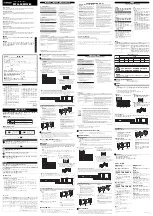
Ter.
DESCRIPTION
v(V)
i(A)
NC
COM
NO
Programmable
Output
n.
1
(changeover switch contacts)
(4)
2
+N
Programmable Output n. 1 (intrin-
sic security), protected by fuse
13.8
(2)
1.5
(1)
+A
Programmable Output n. 1 (posi-
tive), protected by fuse
13.8
(2)
1.5
(1)
+B
Positive power supply to periph-
erals, protected by fuse (will be
powered by the battery during
Mains failure)
13.8
(2)
1.5
(1)
M
Negative
0
–
O1
Programmable
Output
n.
2
(Open-Collector)
0
0.1
O2
Programmable
Output
n.
3
(Open-Collector)
0
0.1
AS
10 K
W
Supervised Tamper Line
–
–
RED
BLK
SPK
MIC
Terminals for the Audio Station:
Positive protected by fuse
Negative
Speaker
Microphone
13.8
(3)
0.5
(1)
+
C
R
–
BPI bus for the BPI peripherals:
Positive protected by fuse
Command
Response
Negative
13.8
(2)
1.5
(1)
Ter.
DESCRIPTION
v(V)
i(A)
(5)
RED
BLK
YEL
GRN
Bus for the transceiver:
Positive protected by fuse
Negative
Receiver
Data
13.8
(3)
0.5
(1)
+F
Power supply to detectors (
posi-
tive
), protected by fuse (will be
powered by the battery during
Mains failure)
13.8
(2)
1.5
(1)
T1
:
T4
Terminals programmable as In-
put Line or Output.
–
–
L1
:
L4
Programmable Input Line
–
–
M
Negative
0
–
LE
External telephone line terminals
–
–
LI
Line-sharing devices terminals (for
Answerphone, telephone, fax, mo-
dem, etc.)
–
–
-
Earth Terminal
0
–
e
At default, inputs L1, L2, L3 and L4 are pro-
grammed to signal the following events:
L1 = Detector fault
L2 = Hold-up device fault
L3 = Internal siren fault
L4 = External siren fault.
In order to comply with the EN50131-3 and
EN50131-1 standards, these settings must NOT
be changed.
26
Expandable Hybrid Control Panel
+
C
R
–
BPI device
C
R
+
–
BPI device
R
C
+
–
Panel
Power station
R
C
+
R
C
+
BPI IN
BPI OUT
BPI device
R
C
+
–
Figure 9
Connection of 4 BPI Devices
N.
ADDRESS
1
2
3
4 5 6
7
8
9 10 11 12 13 14 15 16 17 18 19 20 21 22 23 24 25 26 27 28 29 30 31 32
1
(1) 2
(2) 3
(3) 4
(4) 5
Table 5
Assignment of addresses: column
N.
shows the microswitch numbers (refer to the number in parentheses for
the power feeding supply address settings); a
white
square indicates that the respective microswitch must be OFF
and a
gray
square indicates that the respective microswitch must be ON.
















































